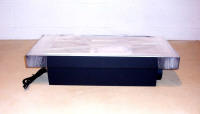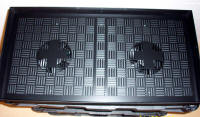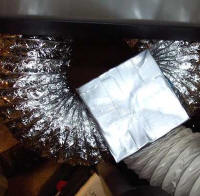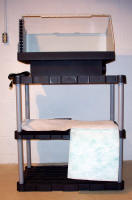|
Artograph Spray Booth Reviewed By John Noack, #23017 |
|
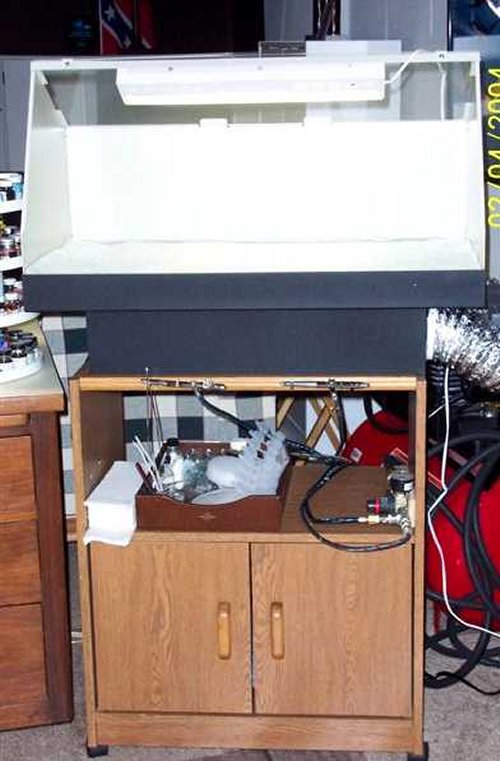 |
|
|
The kind folks at Artograph (www.artograph.com) responded to my request for review products by shipping a large heavy box to Noack Modeling Central. I'm pleased to be able to bring you a review of this exceptional product as a result.
First, let's get the price out of the way. This unit has a suggested retail price of $499.95. For many of us, that's a deep bite into the pocketbook, but (there's always a but): What's the cost of a new set of lungs? I've used the Journal as a lectern before to preach the gospel of modeling safety. Guys, like it or not, we deal with some dangerous stuff in the way of airborne solids and solvents. One of the most effective things you can do to ensure the safety of you, your family, and your pets (not to mention getting better finishes on your models) is to use an effective, positively ventilated paint booth. Use of an OSHA-approved face mask with appropriate filter packs for airborne solvents is another, incremental safeguard – but enough preaching. Read Dr. Frank Mitchell's articles on modeling safety if you want to be scared further. And if you don't buy this booth, please make sure you're doing something to keep your lungs pink and healthy.
The Artograph spray system is an all-metal booth incorporating two powerful fans and dual exhausts. The working surface area of this particular booth is 30" wide by 15" in depth, so unless you're building 1/10 scale B-36 kits on a regular basis, there will be no problem fitting your favorite project. The booth comes fully assembled except for the hood unit, which involves installing about 6 sheet metal screws and takes 5 minutes. A clear plastic cover (not unlike the sneeze guard at your local salad bar) permits plenty of ambient light to come through. I installed a $6.99 Wal-Mart fluorescent lamp under the cover by using some of the predrilled holes on the upper front cover support - took another 5 minutes to do this and it really brightens up the work area. (The predrilled holes are thoughtfully put there to allow you to hang items over the booth to paint them).
The key to the Artograph booth's excellent operation is a multi-layer filtration system that traps much of the particulates and solvents coming out of the working end of your airbrush or spray can. Starting from the top, a replaceable pre-filter sheet traps much of the overspray. The next layer down is a "mid-filter" that incorporates a tacky lower surface to trap any particles that make it through the pre-filter. The final item is a poly-carb filter layer that gets the remainder of the solvents. As a result of this three ply filter, Artograph claims that the unit can be used without venting the exhaust to an outside duct. I prefer to play it safe and installed a dryer vent duct line to the outside. More on this later.
The unit can be built with the outlets facing either side, so you can arrange it to fit your particular layout needs. An on-off switch on the opposite side of the base controls the two very powerful fans. Despite the high airflow rate of the unit (370 CFM), it's relatively quiet in use, probably because the filters on top of the fans act as mufflers to limit the noise.
Since there are two outlets (one for each fan/motor) Artograph recommends running two separate exhaust lines to the outside. I already had a single exhaust duct installed in my basement window, so I modified this slightly by installing two short exhaust lines which then combine into a manifold (made from the cardboard box the duct hose comes in). My single exhaust line exits the manifold and attaches to the vent in my window. Elegant? No. Simple and cheap? Yes.
So, in summary - a finely engineered, high end unit guaranteed to reduce the danger of personal and workpiece contamination. I'd like to see a "Y" duct included or offered as an option to allow single exhaust lines, but that's not a big deal. Artograph also offers larger and smaller units, and their Model 1520 single fan system with a retail price of $279 would fit most modeler's needs just fine.
Bottom line: Highly recommended if you want to stick around for a while and build more models! |
|
|
Information, images, and all other items placed electronically on this site are the intellectual property of IPMS/USA ®. |
|
